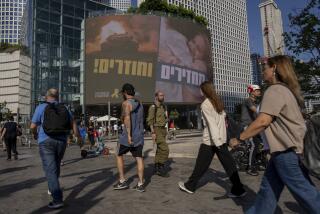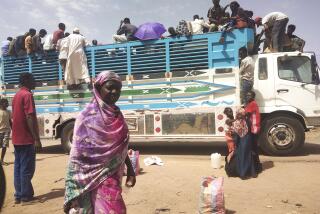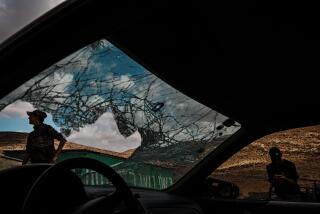Ruined School Symbolizes Somali Chaos, Devastation : Africa: War’s brutality and destruction have devoured a once-proud university and much of nation.
MOGADISHU, Somalia — The National University of Somalia sits on a slight rise overlooking the capital, an ironic symbol of what has become of this country. What was once a center of African education is now a relic, devoured by the chaos and brutality of civil war.
It has no classrooms, no students, no facilities, no laboratories, no telephones, no electricity--nothing, not even a chalkboard. Even the toilet bowls have been ripped out.
Where once tens of thousands of young Somalis trained to be doctors, engineers, geologists, lawyers, philosophers and poets, only lethargic refugee squatters sit, waiting for a handout or starvation.
It wasn’t always that way. Before Somalia plunged full bore into national suicide more than two years ago, a faculty of almost 2,000 professors and lecturers taught here. The 20,000 students studied and lived on a 100-acre campus, beautifully landscaped with desert plants and trees. Winding paths and streets carried the scholars among more than 100 classroom buildings, dorms and pleasant faculty bungalows.
This was a setting easily recognizable by any collegian in Southern California. Students here once sat in modern, air-conditioned classrooms; they read from up-to-date texts and had access to the same equipment as many universities in Europe or the United States.
“We could train as good a doctor as you” Americans, said Dr. Mohammed Abid Hassan, a medical professor. “We had orthopedic surgeons, cardiologists, everything. Maybe we didn’t have all the luxurious equipment for treatment, but we practiced real, effective medicine.”
Hassan Sheik Ahmed, a prominent intellectual and law professor, spoke of the excitement of discussion in the classrooms. “We weren’t tied to rote methods. We had exciting, even angry exchanges with students. It was invigorating.
“We had one of the best agronomy schools in Africa,” he added. “We taught other countries about crops, soil conservation. It was impressive. And we did it ourselves. We didn’t need foreign experts.”
“Yes, I heard that,” said a European diplomat who has been here for nearly three years. “But it isn’t that way now. But, then, nothing here is the way it was.”
For sure. Certainly not Mogadishu, a sprawling seaside city of half a million people. With the exception of a handful of Moorish-style ancient buildings, the city was a mess even before the civil war, according to longtime residents.
Large Italianate villas crouched behind high walls topped with jagged glass. Houses were built without relationship to each other. The streets were unpaved and covered with garbage and litter. Office buildings and other large structures were made of featureless concrete, a legacy of the long Soviet presence.
But even a crumbling, smelly, Russian-designed building is better than what the city looks like now. The downtown is reminiscent of the scenes depicted in photographs of Richmond, Va., after the Civil War or Berlin after World War II.
Ragged remnants of walls, roofless and windowless, characterize buildings in this city. They function now only as barriers, marking the division of the city between its two warring clans.
The rest of Mogadishu is a little better. But it is safe to say that not a building or home here was untouched by violence. Those not destroyed by shells were stripped and looted. There is not a single working telephone in the entire country, besides the satellite phones brought in by foreign journalists and the U.S. military.
Nor are there running water or lights, functioning refrigerators or ovens or other working electrical appliances, except those driven by gas-powered generators owned by a few warlords, the foreign press and the military.
Those relatively few people who have food to eat cook it over tiny wood fires, which often provide the only light at night.
“You can see that we had all that before,” said Sheik Ahmed, pointing out the glass-less window of his nearly roofless villa at telephone and electric utility poles. Standing erect in the rubble, the concrete poles are like totems to a long-dead past. None has a wire attached; they were all ripped down for their metal.
It is one of the many anomalies here to see wrecked buildings with faint signs advertising electric repairs; one sign near the old downtown is illuminated at night by a tiny kerosene lantern. “All Electrics Repaired Here,” the door sign says.
With almost no functioning buildings and no utilities, there is, of course, no real business. There are no banks, no credit, no available resources.
And there is no work. “It is safe to say,” said a Swedish relief worker who has lived in Somalia most of her adult life, “that no one here has a real job.” Lawyers wash dishes in the one functioning hotel or they hire out as interpreters to foreign reporters. A respected geologist is a driver for a major American newspaper.
The stalls scattered along streets throughout the city have few goods to sell--grapefruit, bananas, out-of-date cans of instant coffee, a rusty thermos jug.
There is one exception: the arms market. Although the American military intervention has driven down the price of an AK-47 assault rifle from $350 to $75, the market does a thriving business, particularly in handguns that are easy to hide. Profit margins here have also been boosted by the sale of the dozens of cameras and other gear stolen at gunpoint from television and newspaper photographers.
Without work, thousands of Somalis spend their days just standing around. The gates of international organizations, the entrances to foreign embassies and American military camps all have hundreds of people standing outside all day long.
The people do little more than stare, though some beg, some try to sell cigarettes and handicrafts and some find such spots an easy place to stage robberies and carjackings.
If there is a growth occupation it is crime.
“We are raising our children to be criminals,” said Said Ali Mohammed, a lawyer who taught at the university. “We train them as pickpockets and graduate them into thieves and killers.”
A harsh assessment, but a real one. Any foreigner who steps into the streets is immediately surrounded by dozens of pressing children whose tiny hands rove all over the body and into pockets.
Where there are no American patrols, the guns appear, often brandished by 12-year-olds.
“What other work do they have?” asked a senior U.S. official recently. “Robbing is how they stay alive.”
What brought Somalia back to such a primitive state? The immediate explanation is the civil war. Besides the destruction of the infrastructure, the fighting and starvation killed at least 300,000 people. More than 1 million are in refugee camps in neighboring countries and as much as 20% of the country’s 6 million population now lives as displaced people.
A noted feature of Mogadishu and the other urban centers of Somalia are the little geodesic domes built of sticks and green plastic. Families of eight, 10, even more crowd into these huts no larger than a back yard tool shed.
If the war explains some things, however, what explains the war? The immediate, superficial answer would be the revolt against deposed dictator Mohamed Siad Barre; that battle developed into a rivalry between former allies.
But deeper than political rivalry lies the real answer: Somalia’s clans. These social structures are rooted in an ancient dispute between nomads and farmers, said Sheik Ahmed. “The nomads, mostly camel herders, had no use for those they looked down on as earth scratchers.” And, he said, “just as on the American frontier the incursion of fenced farmland set off range wars by cattlemen, the increase here in cultivated land angered the nomads who found they no longer had all the land they wanted for movement.”
These differences were sharpened by the existence of family clans. The nomads were widely related to one another; so were the farmers. There was virtually no connection between the two groups.
Always exclusionary, the clans have become the machinery for nearly all activity. Political rivalries are structured along clan lines, neighborhoods are built on clan lines, as are occupations. Whole cities are made up of a single clan and God help a member of another clan if he wanders in.
Can Somalia change? In the immediate future, it is possible but unlikely. According to U.N. studies, it will take billions of dollars to rebuild this nation, and the money is unlikely to come.
U.S. special envoy Robert B. Oakley says the United States neither “should nor will” provide major financial aid to Somalia. Neither will other Western nations, it seems. Recent economic missions from Germany and Japan left here last week, saying there is no opportunity for investment in such an unstable country.
But even if the clans reconcile and money is found, the real question remains: Can it last?
Oakley thinks there is no choice. Even the strongest clan member must know now that Somalia cannot go on fighting, that peace is better than war, he says.
Sheik Ahmed thinks differently. “I used to feel Somalia had golden opportunities. We are a homogeneous people racially. We are all of the same religion. We have fertile land and intelligent people. But it evidently isn’t enough. It wasn’t in the past and I can’t say that it will be in the future.”
More to Read
Sign up for Essential California
The most important California stories and recommendations in your inbox every morning.
You may occasionally receive promotional content from the Los Angeles Times.










